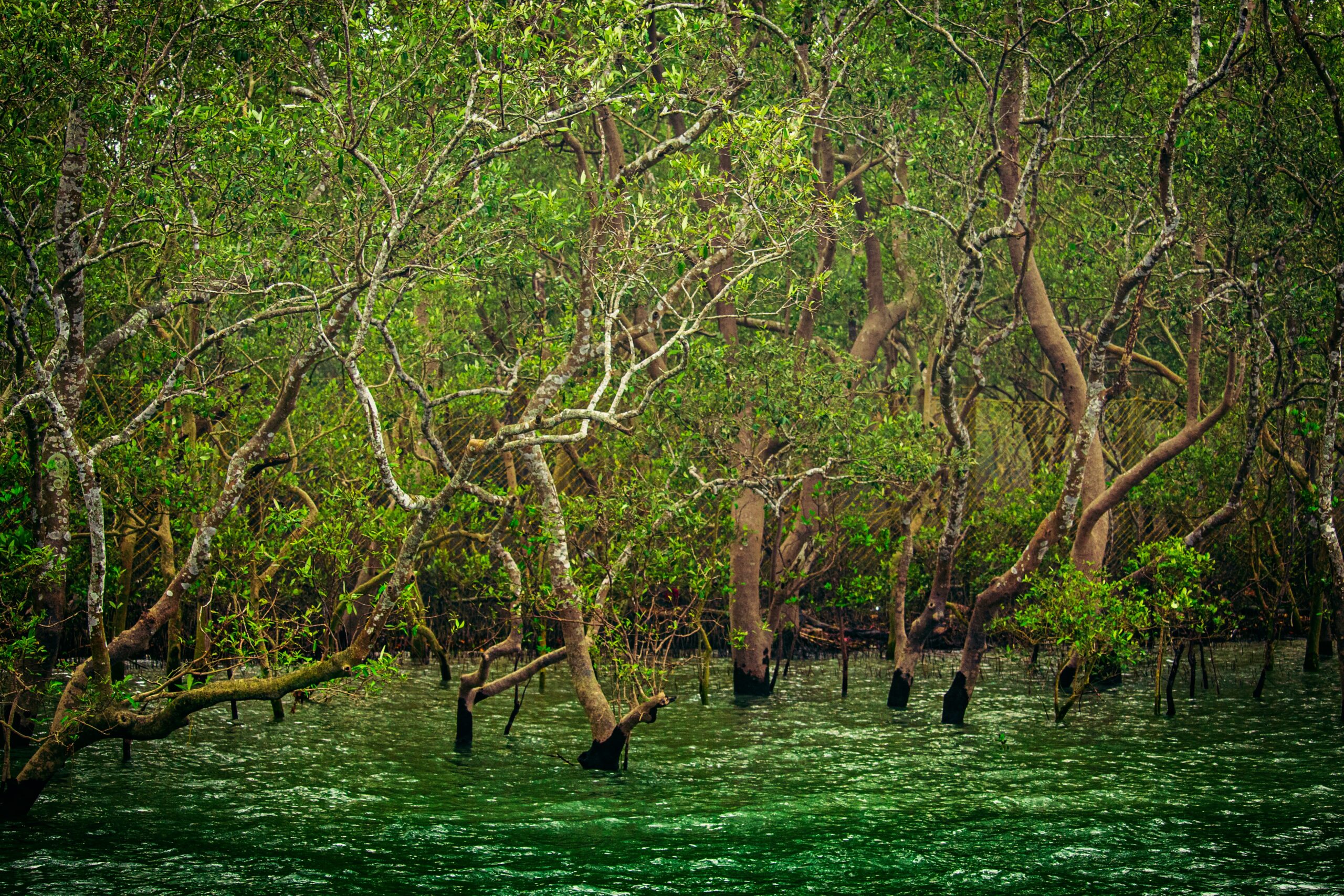FINDING SOLIMAR
Throughout my time studying food security at the University of Edinburgh, I was vaguely aware of the advantages of sustainable tourism development projects in vulnerable areas of the world, but I wasn’t clear about how these efforts can actualize environmental and social improvements in practice. A friend of mine working in ecotourism then introduced me to Solimar, and I was energized by their results and success. Solimar connects people with economic opportunities and promotes environmental initiatives through sustainable tourism development.
I learned that Solimar was doing work in the Sundarbans, the world’s largest mangrove forest, and I became hooked on the idea of getting involved in their project. Throughout my course in food security, I developed a fascination with mangroves and how they can support food security in the world’s vulnerable coastal areas. I then got connected with one of Solimar’s project partners, the Bangladesh Environment and Development Society (BEDS). BEDS is a Bangladeshi NGO pursuing cooperative solutions to the country’s deteriorating mangrove habitat, coastal instability, and livelihood vulnerabilities among Bonojibi people (forest dwellers) who live in and around the Sundarbans. I was able to piggyback my research onto an existing project in the area – USAID contracts Solimar to develop the Bangladesh Ecotourism and Conservation Alliance (BECA) in collaboration with BEDS.
the world’s largest mangrove forest, and I became hooked on the idea of getting involved in their project. Throughout my course in food security, I developed a fascination with mangroves and how they can support food security in the world’s vulnerable coastal areas. I then got connected with one of Solimar’s project partners, the Bangladesh Environment and Development Society (BEDS). BEDS is a Bangladeshi NGO pursuing cooperative solutions to the country’s deteriorating mangrove habitat, coastal instability, and livelihood vulnerabilities among Bonojibi people (forest dwellers) who live in and around the Sundarbans. I was able to piggyback my research onto an existing project in the area – USAID contracts Solimar to develop the Bangladesh Ecotourism and Conservation Alliance (BECA) in collaboration with BEDS.
Getting connected with the larger Solimar, BEDS, and BECA networks granted me access to a world of sustainable development I thought I could only encounter much later in my career. These connections helped me better understand some of the vast economic and environmental results Solimar and BEDS have achieved with their program interventions.
Existing research in Bangladeshi mangrove preservation has focused on the ecological stability of the region. Working within existing frameworks, I proposed to contribute a food security angle to the existing data with my dissertation research, studying the effects of participation in mangrove conservation efforts on the four food security pillars in local households.
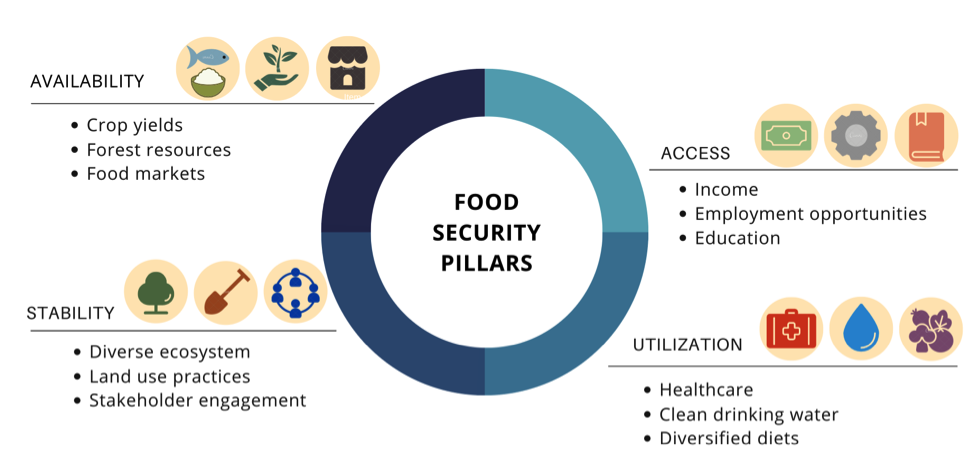
Thus, my research project was born:
Can Mangrove Conservation Interventions Increase Short-Term Food Security for Banojibi villages, while working towards Long-Term Ecological Stability, in The Sundarban Forest of Bangladesh?
A Case Study Evaluation of Local Perspectives on Bangladesh Environment and Development Society Mangrove Conservation Initiatives
The experience blew me away; I was able to travel to Bangladesh and interview stakeholders in and around the Sundarbans. I spoke with mangrove conservation project managers, forest rangers, farmers, ecotour guides, students and professors at Khulna university, and other interested parties to better understand the influence of mangrove conservation efforts on local livelihoods. The data collected from my study has since helped to inform food system lens for BECA project interventions in the Sundarban Reserve Forest, including the monitoring, evaluation, and learning of implemented project activities, specifically related to food security outcomes.
KEY FINDINGS OF ECOTOURISM IN THE SUNDARBANS ON LIVELIHOOD DEVELOPMENT AND CONSERVATION
The culmination of my field research in the Sundarbans revealed some compelling themes linking ecotourism development to the improvement of livelihoods, including economic opportunities and food security outcomes for local people. BEDS’ ecotourism sector is one of five sectors (including agriculture, aquaculture, non-forest timber products, and mangrove reforestation) that is supporting regional environmental security in the Sundarbans. In addition to promoting mangrove health and coastal stability, BEDS’ ecotourism sector also facilitates cultural exchange between local people and tourists, and increased awareness of the vulnerable Sundarbans habitat. It also supports mangrove conservation in its emphasis on sustainable development, prioritizing local, small-scale, and sustainable materials for infrastructure, environmental education, and cultural exchange among local people and tourists. These actions increase awareness of the Sundarbans’ value and reduce resource pressures on mangrove habitat, in lieu of large-scale development of tourist facilities, and associated environmental degradation. The following statistics from my research showcase the results of ecotourism opportunities in the study area:
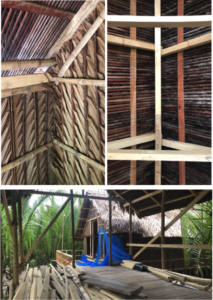
- A large majority (87.5%) of interviewees in the sector agreed that mangrove conservation initiatives have increased their access to professional opportunities.
- Before the BEDS intervention, 50% of interview participants reported working as domestic and day laborers. All of those (37.5%) who reported working as domestic laborers were women. After getting involved in BEDS programming, however, 100% of people reported that their primary income came from ecotourism opportunities.
- Over 71% of interview participants noted that increased opportunities for extended community partnerships between sectors could add value to ecotourism in the area. Specifically, 50% noted that opportunities to experience village lifestyle and culture would increase the value of ecotourism activities. Another 50% also mentioned healthier mangroves and Sundarban biodiversity as a driver of ecotourism value.
- Ecotourism in the study area contributed to increased income and economic opportunities for women (affecting access to food), increased access to drinking water (affecting the utilization of food), increased ecological stability, improved land use practices, and cooperative partnerships (affecting the stability of local food systems).
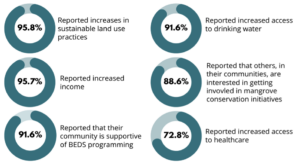
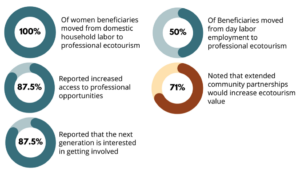
Data from the ecotourism sector presented compelling opportunities for commercial cooperation and cultural-exchange between BEDS’ five sectors. For instance, BEDS’ ecotourism adds value to its local communities by developing increased employment opportunities and increasing regional awareness of the state of the Sundarbans. For instance, shrimp yields are highest from September to October in the study area. This is also the most popular tourist season, as it is the dry season in Bangladesh. This overlap could provide a valuable opportunity for pop-up retail markets in the aquaculture sector, and the diversification of market opportunities for farmers. This program also is one of the limited professional avenues for local people,especially women. This is a valuable avenue into the professional workforce for people in the study area, and a compelling avenue for reducing regional gender inequities.
WHERE TO GO FROM HERE?
The ecotourism sector in Bangladesh is facing an interesting opportunity. The introduction of a 6 km bridge across the padma river on June 25, 2022, which will streamline transportation between Bangladesh’s metropolitan hubs, including Dhaka and Khulna, and the co
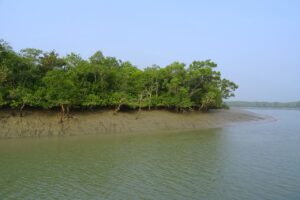 astal part of the country, is certain to increase regional tourist traffic. Unrestricted tourism could be disastrous for the area. However, increasing measured and intentional opportunities for sustainable ecotourism development could present an opportunity for increased awareness of the SRF, and an influx in economic opportunities in depressed local markets. The influx in capital, as a result of ecotourism, can change the micro and macroeconomic landscape of local communities in the world’s mangrove supporting regions. These benefits are critical to regional food security; economic opportunities like this are positively correlated with increased access to food, a diversified diet, and increased stability of local food systems.
astal part of the country, is certain to increase regional tourist traffic. Unrestricted tourism could be disastrous for the area. However, increasing measured and intentional opportunities for sustainable ecotourism development could present an opportunity for increased awareness of the SRF, and an influx in economic opportunities in depressed local markets. The influx in capital, as a result of ecotourism, can change the micro and macroeconomic landscape of local communities in the world’s mangrove supporting regions. These benefits are critical to regional food security; economic opportunities like this are positively correlated with increased access to food, a diversified diet, and increased stability of local food systems.
HOW CAN DEVELOPMENT OF ECOTOURISM IN THE SUNDARBANS SCALE THESE RESULTS?
These results reveal several compelling themes that highlight the intersections of mangrove conservation efforts in the SIZ, and regional food security:
- Multi-stakeholder initiatives can address opportune connections between local markets and ecosystems, helping to support local mangrove conservation and food availability and access
- Increasing opportunities for ecotourism will increase opportunities for the retail sale of premium mangrove-friendly products in food producing sectors
- Increasing opportunities for young people to be involved in ecotourism will improve environmental education and gender equity
- Opportunities for visitor engagement in forest regeneration in the study area will increase opportunities for improving coastal stability and habitat production for the ecotourism sector, and food-production habitats for food producing sectors
Much of what was revealed in this research is already documented in current literature: mature mangrove forests can support food security, and mangrove conservation efforts can support livelihoods. This work adds an additional, targeted food security angle to the field, and contributes to the emerging research about how conservation interventions can also support food security in the short-term, as reforested and protected mangroves grow from saplings to resource-giving trees. Not only can cooperative mangrove conservation interventions, like ecotourism development, endow Bangladeshi communities with food security-supporting services, but these efforts can also stimulate education, a fair distribution of incomes, gender equality, cultural celebration, access to land and ownership, regional climate resilience, and other socio-ecological and economic assets.
WORKING WITH LOCAL PEOPLE
A pillar of Solimar and BEDS’ work in the Sundarbans is to ensure that the perspectives and priorities of local people are centered in every initiative taken on the behalf of the forest that they steward. Results from my limited work in the study area contribute to existing research indicating that conservation interventions are most successful when local communities are involved. Formal interviews and casual conversations with locals revealed to me that there is a robust momentum for mangrove conservation in the region I visited. Community-based mangrove forest management in the Sundarbans, including the development of the ecotourism sector, appeared to be a successful avenue to conservation, based on the results of my research and the perspectives of local people. This avenue for conservation initiatives redistributes the agency of forest conservation from powerful stakeholders to local people who rely on the forests’ resources for their livelihoods. These are the people targeted in Solimar’s work in Sundarbans ecotourism, and these are the people who will most directly influence policy and conservation.
